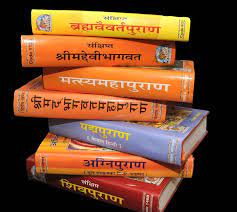The Puranas like Mahabharatam are not homogeneous compositions but are made up of ancient tales and recent additions side by side. The Puranas derived their sources from the common myths and legends that have been popularly current from the vedic times. These myths and legends must have been originally sung by bards belonging to the class of people called ‘saUt’s. Hence most of the Puranas are narrated by ‘saUtpaOraiNak’s. The term Purana occurs in the Brahmanas and Upanishads in the sense of cosmogonic enquiries and ancient tables. In the Mahabharatam the word Purana is used to denote the ancient legendary lore in general dealing with the stories of Gods and the genealogy of sages. In the Upanishads and Puranas, Itihasas are called are called the fifth Veda. The Puranas are spoken as existed from very early times dating even before the Mahabharatam. But the Puranas as we have them now seem to be of recent origin. The ‘AmarkaoSa:’ – Amarakosa defines Puranas as works dealing with five different topics namely the main creation, the genealogy of gods and saints, the secondary creation, the epochs of several Manus and the various dynasties of kings.
‘saga-Sca
p`itsaga-Sca vaMSaao manvantraiNa ca.
vaMSaanaucairtM caOva puraNaM pHcalaxaNama\..’
But the Puranas as we have them now devote only a minor
attention to these, whereas sectarian matter like the worship of one deity or
the other occupies a predominant part. Each Purana is distinctly either
Vaishnavite or Saivaite and recount legends about that particular deity who is
considered as their supreme being and extols the fasts and feasts, ceremonies
and pilgrimages done in honour of that particular deity as a means of
salvation. This Satanism, frequent references to Buddhism and other religions,
the style, the highly artificial nature of stories and the reference to the
kings of the later Dynasties lead us to the conclusions that the earlier ones
among the existing Puranas must have been written after the 1st
century A.D. Thus the ‘ivaYNaupuraNama\’
reliably refers to the Maurya Dynasty, the ‘ma%syapuraNama\’ refers to the Andhra Dynasty and ‘vaayaupuraNama\’ speaks of Gupta Dynasty. Since Bana refers to ‘vaayaupuraNama\’ and great rulers like Harsha are not mentioned in any of the
Puranas, we can infer that the more important Purana including the ‘vaayaupuraNama\’ must have come into being before the 7th century A.D.
though some like the ‘BaagavatpuraNama\’ must have been composed from 10th century A.D. onwards. ‘kumaairlaBa+:’
of 8th century A.D. – a great name in the
The Puranas usually enumerated are ba`*ma
pad\ma ivaYNau iSava ila=\ga gaÉD naard Baagavat Aigna sknd BaivaYyat\
ba`*mavaOvat- maak-NDoya vaamana varah kUma- ma%sya ba`*maaND puRraNa s. Strangely this list with some variations appear in the
Harivamsa, VishnuPurana, Bhagavata Purana and in almost every other Purana as
well.
The Puranas are usually divided into three groups. The
Vishnu, Bhagavata, Narada, Padma, Garuda, Varaha Puranas which glorify Vishnu
are classified as saai<vakpuraNa s. The
Brahma, Brahmavaivarta, Brahmaanda, Markandeya, Bhavishyat and Vamana which
extol Brahma are classified as rajaisakpuraNa s.
The remaining six Siva, Agni, Linga, Skanda, Matsya and Kurma Puranas which
expound the glory of Siva are called tamaisakpuraNa s. All Puranas are ascribed to the common authorship of Vyasa and
are introduced as having been narrated by ]ga`Eavasa\ the son of laaomahYa-Na the saUt to the sages assembled in naOimaSaarNyama\.





No comments:
Post a Comment